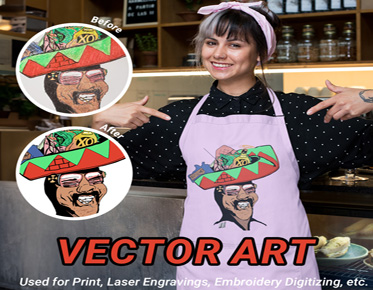5 Ways to Use Vector Art Like a Pro!
Why Vector Art is Popular
Scalability Without Quality Loss
One of the main reasons vector art is so popular is its scalability. Whether you need a small icon for a website or a large banner for a billboard, vector art maintains its quality. This scalability ensures that your designs look professional and polished, regardless of the size.
Flexibility in Design
Vector art provides unparalleled flexibility in design. Designers can easily tweak and adjust elements, change colors, and experiment with different layouts without compromising the quality of the artwork. This flexibility is especially beneficial in dynamic design environments where revisions are frequent.
Easy to Edit and Modify
Editing and modifying vector art is straightforward. Because vectors are made up of individual elements, designers can select and adjust specific parts of the artwork without affecting the entire image. This ease of editing saves time and allows for greater creative exploration.
Common Uses for Vector Art
Branding and Logo Design
Why Vectors are Ideal for Logos
Vectors are ideal for logos because they need to be used across various platforms and sizes. From business cards to large signs, vector logos maintain their sharpness and clarity. This ensures a consistent brand image.
Creating Scalable Logos for Different Platforms
When designing logos, scalability is crucial. Vectors can be resized without losing detail, making them perfect for digital and print media. This adaptability ensures your logo looks great whether on a mobile app or a billboard.
Tips for Designing Effective Vector Logos
When designing vector logos, simplicity is key. Focus on clean lines and bold shapes. Ensure that the logo is easily recognizable at different sizes and remains legible when scaled down. Use vector software like Adobe Illustrator for precise control over your design.
Marketing and Advertising
Vector Art in Digital Advertising
Vector art is widely used in digital advertising due to its scalability and quality. From banner ads to social media graphics, vectors ensure your advertisements look sharp and professional across all devices.
Designing Print Ads with Vectors
Print ads benefit greatly from vector art. Whether designing posters, flyers, or brochures, vector graphics provide high-resolution output without pixelation. This results in vibrant and eye-catching print materials.
Custom Illustrations for Marketing Campaigns
Custom vector illustrations can make marketing campaigns stand out. They offer a unique and tailored look that can align perfectly with your brand's identity. Custom vectors can be used in various marketing materials, providing a cohesive visual experience.
Web and App Design
Using Vector Icons and Illustrations
Vector icons and illustrations are essential in web and app design. They ensure a clean, modern look and can be easily scaled for different screen sizes, maintaining consistency in user interfaces.
Responsive Design with Vector Graphics
In responsive design, elements must adapt to various screen sizes and resolutions. Vector graphics excel in this area, as they can be resized without losing quality. This makes them perfect for creating adaptable, high-quality visuals for websites and apps.
Enhancing User Interfaces with Vectors
Vectors enhance user interfaces by providing crisp and clear icons, buttons, and illustrations. They improve the visual appeal and usability of digital products, making interactions more intuitive and engaging.
Product Packaging and Labeling
Designing Eye-Catching Packaging
Vector art is ideal for designing product packaging. It allows for intricate designs that remain sharp and vibrant when printed. This ensures that your product stands out on the shelf and attracts customers.
Vector Art for Labels and Tags
Labels and tags benefit from vector art's clarity and precision. Whether small or large, vector graphics ensure that every detail is legible and professional, enhancing the overall appearance of your product.
Ensuring Print Quality with Vectors
Using vector art in packaging and labeling ensures high print quality. Vectors provide clean lines and accurate colors, resulting in professional-looking packaging that reflects well on your brand.
Merchandise and Apparel Design
Creating T-Shirt Designs with Vectors
T-shirt designs created with vector art can be scaled to fit any size without losing quality. This makes vectors ideal for apparel design, ensuring that your graphics look great on everything from small to XXL shirts.
Vector Art for Promotional Items
Promotional items such as mugs, bags, and hats benefit from vector graphics. Vectors ensure that your designs are sharp and vibrant, making your promotional items attractive and professional.
Tips for Designing Vector-Based Merchandise
When designing vector-based merchandise, focus on simplicity and bold lines. Ensure that the design is easily recognizable and looks good in different sizes. Use vector software to create precise and scalable artwork.
Illustrations and Artwork
Digital Illustrations with Vectors
Digital illustrations created with vectors are precise and vibrant. Vectors allow for detailed and intricate designs that can be easily modified and scaled, making them ideal for digital artwork.
Combining Vectors with Other Media
Combining vector art with other media can create unique and dynamic designs. Vectors can be integrated with raster images, text, and other elements to create complex and engaging artwork.
Selling Vector Art as Stock Images
Vector art can be sold as stock images, providing a source of income for designers. Vectors are highly sought after for their scalability and quality, making them valuable assets for various design projects.
Vector Art in Advertising Campaigns
Designing Cohesive Campaign Elements
Vector art is ideal for designing cohesive campaign elements. Vectors ensure that all aspects of your campaign are consistent and professional, creating a unified and effective message.
Vector Art for Billboards and Large Displays
Billboards and large displays benefit from vector graphics due to their scalability and quality. Vectors ensure that your designs are clear and vibrant, attracting attention and conveying your message effectively.
Case Studies of Successful Campaigns
Examining case studies of successful campaigns can provide valuable insights into the use of vector art. Learn from real-world examples to enhance your own advertising efforts.
Creating Custom Vector Art
Tools and Software for Vector Design
Several tools and software are available for creating custom vector art. Adobe Illustrator, CorelDRAW, and Inkscape are popular choices that offer a range of features for vector design.
Learning Vector Illustration Techniques
Learning vector illustration techniques can enhance your design skills. Online tutorials, courses, and practice can help you master the tools and create stunning vector art.
Tips for Developing Your Own Style
Developing your own style is essential for creating unique and recognizable vector art. Experiment with different techniques, colors, and compositions to find what works best for you.
Optimizing Vector Art for Different Platforms
Exporting for Web vs. Print
When exporting vector art, consider the platform. For web use, export in formats like SVG or PNG. For print, use formats like EPS or PDF to ensure high quality.
Ensuring Compatibility Across Devices
Ensure that your vector art is compatible across different devices and platforms. Test your designs on various screens and resolutions to maintain quality and consistency.
Best Practices for File Formats
Follow best practices for file formats to ensure compatibility and quality. Use appropriate formats for different purposes and maintain organized and well-named files.
Challenges and Solutions in Vector Art
Overcoming Common Design Challenges
Overcoming common design challenges involves practice and knowledge. Learn from mistakes, seek feedback, and continuously improve your skills to create better vector art.
Troubleshooting Vector File Issues
Troubleshooting vector file issues requires understanding the software and file formats. Common issues include compatibility problems, corrupted files, and scaling errors. Address these issues promptly to maintain quality.
Tips for Maintaining Quality in Edits
Maintaining quality in edits involves careful planning and execution. Use non-destructive editing techniques, keep backups, and regularly review your work to ensure the highest quality.
Future Trends in Vector Art
Emerging Technologies and Tools
Stay informed about emerging technologies and tools in vector art. Innovations like AI-assisted design tools and augmented reality are shaping the future of vector graphics.
Trends in Vector Art Styles and Usage
Trends in vector art styles and usage are constantly evolving. Keep up with the newest trends to keep your designs fresh and relevant.
Predictions for the Future of Vector Graphics
Predictions for the future of vector graphics include advancements in software capabilities, increased integration with other media, and the growing importance of vector art in digital and print media.
FAQs About Vector Art
Addressing Common Questions
Address common questions about vector art to help users understand its benefits and applications. Provide clear and concise answers to enhance their knowledge.
Providing Practical Tips and Advice
Share practical tips and advice for working with vector art. These insights can help users improve their skills and create better designs.
Offering Additional Resources for Learning
Offer additional resources for learning, such as online tutorials, courses, and books. Encourage users to explore these resources to enhance their vector art skills.
Vector art is incredibly versatile and widely used in various fields, from branding and marketing to web design and animation. Its scalability, flexibility, and quality make it an essential tool for designers. Explore the world of vector art to discover its potential. Experiment with various techniques, tools, and styles to determine what works best for you.
Getting started with vector design involves practice and learning. Use vector software, follow tutorials, and seek feedback to improve your skills and create stunning vector art.


